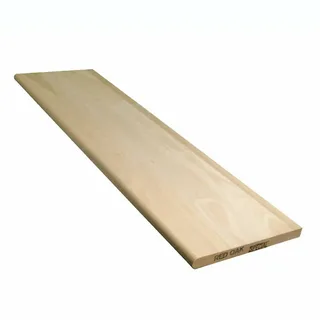Some home upgrades are purely cosmetic. Others improve functionality. But every once in a while, there’s a choice that does both—beautifully. If you’re rethinking your stairs, one of the smartest and most timeless decisions you can make is to upgrade to Red Oak stair treads.
Why? Because they strike the perfect balance between beauty, strength, and value. Whether you’re renovating a historic home or finishing a new build, red oak is a standout choice that blends seamlessly with virtually any design style.
Let’s take a closer look at why Red Oak continues to be one of the most trusted woods in stair construction—and why it might be the perfect fit for your next project.
What Makes Red Oak So Special?
Red oak (Quercus rubra) is one of the most popular hardwoods used in North America—and for good reason. With its warm, reddish-brown hue and open grain texture, red oak brings a natural elegance to any interior. But it’s not just about aesthetics.
Here’s why red oak is the gold standard for stair treads:
- Strength & Stability: Red oak is a hardwood that handles daily wear without denting or warping easily. Its Janka hardness rating of 1,290 makes it ideal for high-traffic areas like staircases.
- Design Flexibility: The grain pattern and tone complement a wide range of stains, finishes, and architectural styles—from rustic to contemporary.
- Sustainability: Sourced widely across North America, red oak is a renewable, eco-friendly choice.
- Affordability: Compared to exotic hardwoods, red oak delivers excellent performance at a reasonable price.
In other words, it’s a smart, stylish investment—especially when you opt for professionally milled Red Oak stair treads from trusted suppliers who ensure consistent quality.
Prefinished vs. Unfinished: Choosing What Works for You
When shopping for stair treads, you’ll often face the choice between prefinished and unfinished products. Here’s what to consider:
Prefinished Red Oak Stair Treads
- Ideal for fast installs and clean job sites.
- Factory finishes are often more durable and uniform.
- Great for matching to existing flooring or trim.
Unfinished Red Oak Stair Treads
- Gives you complete control over color and finish.
- Perfect if you’re staining to match unique floors or furniture.
- Allows on-site customization during new builds or full-scale remodels.
Both options provide the same great base—solid red oak. It really comes down to whether you want to control the final look or save time with a ready-to-go solution.
Design Inspiration: Red Oak That Works With Any Style
One of red oak’s biggest advantages is its versatility. No matter your home’s vibe, there’s a red oak finish that fits.
Here are some ideas:
- Modern Farmhouse: Pair red oak treads with white risers and black railings for high-contrast charm.
- Classic Traditional: Use a medium-brown stain to complement cherry or walnut furnishings.
- Clean & Contemporary: Keep it natural with a clear satin finish and minimalist metal railings.
- Industrial Edge: Combine unfinished red oak treads with matte black brackets and exposed hardware.
And since red oak plays nicely with other hardwood flooring species, it’s easy to create a cohesive look across multiple levels of your home.
Installation Tips for Long-Lasting Results
Red oak may be durable, but installation still matters. Here’s how to get the best out of your stair upgrade:
- Let treads acclimate to your space for 48–72 hours before installing.
- Use high-quality adhesives and fasteners to avoid creaking.
- Apply finish evenly on all sides to seal against moisture.
- If using unfinished treads, test stain on a sample piece first for color accuracy.
- Avoid direct sunlight post-installation to prevent premature fading.
And don’t forget: even though red oak is tough, adding a runner or rug can extend tread life and add extra traction—especially in homes with kids or pets.
Why Red Oak Is a Long-Term Win
Unlike some trendy materials, red oak doesn’t just look good—it performs. Here’s why homeowners and contractors consistently come back to it:
- It resists daily wear better than softer woods like pine or poplar.
- It’s easy to refinish and refresh—even years later.
- It boosts property value through timeless appeal and durability.
- It’s readily available, meaning fewer delays during sourcing.
Plus, with staircases becoming more of a design feature in open-concept homes, investing in visible elements like red oak treads pays off both aesthetically and functionally.
Final Thoughts: Red Oak Stair Treads Are an Investment in Everyday Luxury
If you’re going to walk on something every day, it should be strong, safe, and beautiful. That’s exactly what Red Oak stair treads offer. They’re not only a practical upgrade, but a long-term design decision that enhances the character and quality of your home.
Whether you’re going DIY or working with a builder, red oak brings warmth, consistency, and confidence to every step—literally.
So, if you’re ready to turn your stairs into a statement piece, red oak is a choice that’s proven, professional, and truly timeless.


